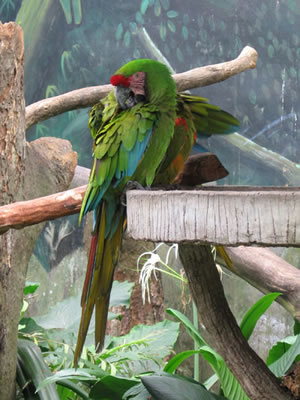Parrots are well known for their intelligence and their ability to mimic human speech.
There are over 300 species of parrots on Earth, many in the tropical rainforests of South America and Australia, fewer in the Asian and African tropical rainforests.
Parrots are the nosiest of all of the animals of the rainforest, with their raucous voices and constant activity.
 Most parrots have a vivid plumage, with green one of the dominant colors.
Most parrots have a vivid plumage, with green one of the dominant colors.
The parrot's feet and beak are well adapted to life in the rainforest.
Its feet are zygodactylous-two toes point forward and two point to the rear. This allows the parrot to establish a viselike grip on branches. Short legs give the bird added stability while climbing and perching.
A parrot uses its beak to climb. It grasps a higher branch with the beak while moving its feet forward.
The beak is specifically adapted for cracking nuts, such as the tough-shelled Brazil nut. The complex pivoting bones of the skull let the upper part move as well as the lower.
The beak's scissorslike cutting edges are immense- tough aviary wire is no match for a large, powerful macaw.
Parrots are hole-nesting birds, choosing safe sites in tall rainforest trees.
Mating and Reproduction
Courtship is simple: the male may bow a few times before the female, and then flick his wings and wag his tail.
Some of the lories, such as the black-capped lory (Lorius lory) expose the underside of their wings.
The male then feeds the female regurgitated food shortly before copulation.
After mating, the female lays two to four pure white eggs on to the floor of the tree hole.
Most parrots do not line nests.
The female incubates the eggs by herself.
During this time, her mate feeds her regurgitated food.
After an incubation period of three weeks, the naked, helpless young hatch.
The female feeds the chicks on a creamy paste of regurgitated food for the first few days of their lives.
After about a week, the male helps her until the young can fend for themselves.
In many species, the young do not leave their parents until the following breeding season.